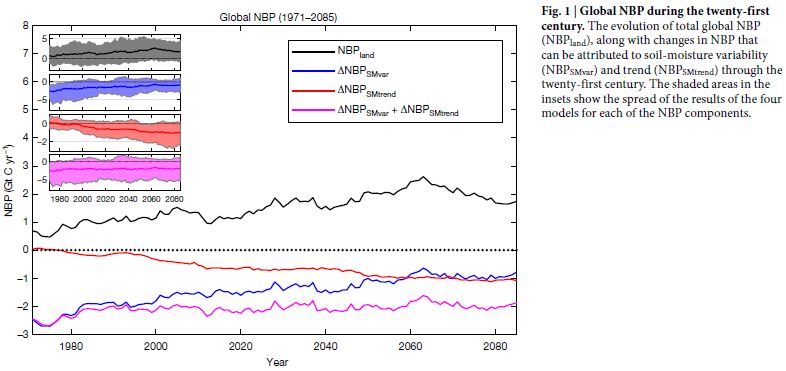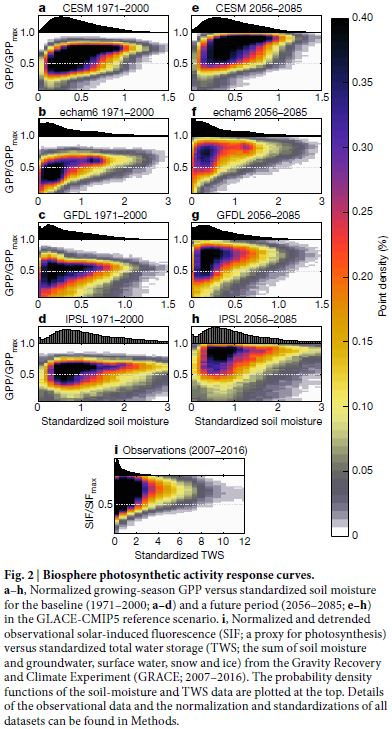11 September, 2020 (Green, nature, SMC->NBP)
Green, J.K., Seneviratne, S.I., Berg, A.M. et al. Large influence of soil moisture on long-term terrestrial carbon uptake. Nature 565, 476–479 (2019). https://doi.org/10.1038/s41586-018-0848-x
Overview
The authors concluded that soil moisture has substantial effect on long-term net biosphere productivity (NBP, a.k.a. NEE?) using a global satellite product of SIF and TWS (GRACE) and multi-model ensemble from the GLACE-CMIP5 project. They explained that the SMC effect was attributable to non-linear response of NBP to SMC. Also, they emphasized the need for better improvement representations of CO2 fertilization effect in models, as it is a basis of their results.
SMC reduction and water-limited ecosystem
The authors decomposed changes in the total NBP into changes due to:
- dNBPSMvar: soil moisture variations from the climatological annual cycle (i.e. seasonal mean)
- dNBPtrend: longer-term soil moisture trends (i.e. 30-year running mean)
- dNBPothers: CO2 fertilization and temperature effects
- error: all other limiting factors

Figure 1:
- dNBPSMvar + dNBPtrend (purple) remained negative during the period: SMC reduces NBP.
- Nevertheless NBPland increased until it met a peak: dNBPothers has significant effect.
- this means that model representations of CO2 fertilization effect is crucially important for the projection.
- The contribution of dNBPtrend (dNBPSMvar) gradually increased (decreased).
- Once an ecosystem put in a water-limited condition, the intra-annual variability becomes less effective.
- ESMs agreed that there is a peak point for the global NBP.

Figure 2:
- All ESMs and observations (i) showed that actual GPP exponentially (?) decreases when SMC becomes less than a certain amount (i.e. turning to the water-limited condition).
- SMC decreases –> E decreases –> less cooling effect (temperature increases)
- SMC decreases –> E decreases –> VPD increases –> stomatal closure –> photosynthesis decreases –> NBP decreases
- SMC decreases –> (Ra / GPP) ratio increases + decreased photosynthesis –> NBP decreases
- SMC decreases + increased temperature –> more fire occurrences –> NBP decreases
- Therefore, it is also important to have realistic representations of vegetation responses to SMC reduction.
Etc
- increased temperature lengthens the growing season length in mid- and northern latitude +
reduced cloud coverage increases available radiation in energy-limited regions
= remains as a CO2 sink
Methodology
Three experimental runs: a reference (CTL), ExpA, and ExpB
- CTL: CMIP5 historic run + RCP8.5 scenario (SMC and CO2 fertilization are accounted)
- ExpA: CTL + mean climatological SMC forcing (seasonal mean SMC) –> remove soil moisture variability
- ExpB: CTL + 30-year running mean SMC –> SMC trend
dNBPSMvar = dNBPCTL - ExpB: exclude the effect of long-term SMC trend (?)
dNBPSMtrend = dNBPExpB - ExpA: exclude seasonal variability to remain the long-term variability only (?)